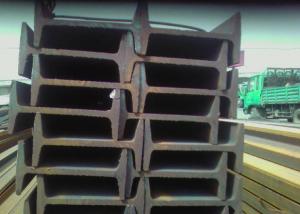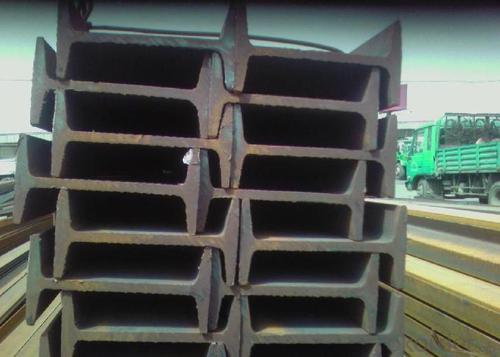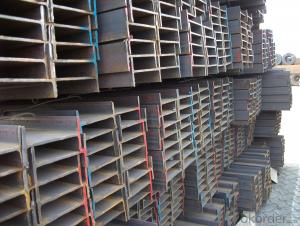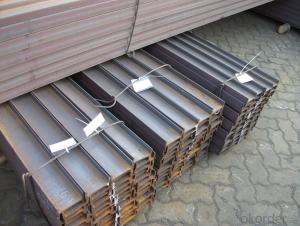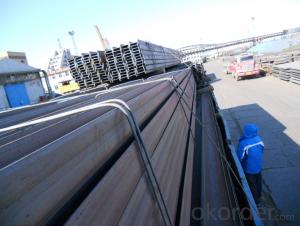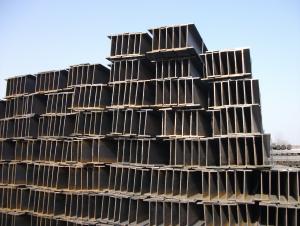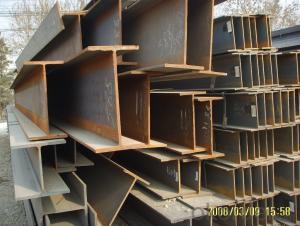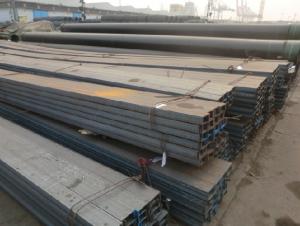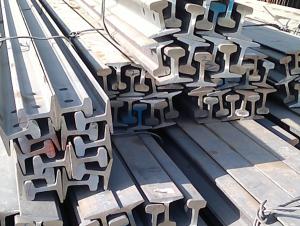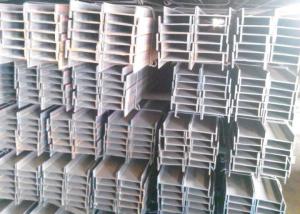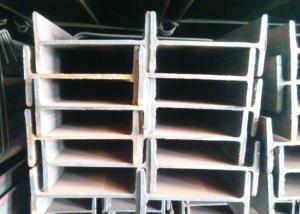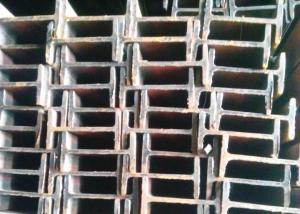IPE/IPEAA Beam Steel
- Loading Port:
- Tianjin Port, China
- Payment Terms:
- TT or LC
- Min Order Qty:
- 25MT m.t.
- Supply Capability:
- 10000MT m.t./month
OKorder Service Pledge
OKorder Financial Service
You Might Also Like
Specifications of IPE/IPEAA Beam Steel
1. Product name: IPE/IPEAA Beam Steel
2. Standard: EN10025, GB Standard, ASTM, JIS etc.
3. Grade: Q235B, A36, S235JR, Q345, SS400 or other equivalent.
4. Length: 5.8M, 6M, 9M, 10M, 12M or as your requirements
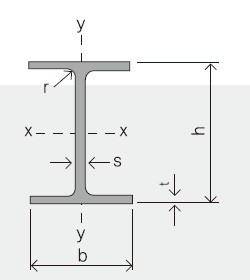
|
Section |
Standard Sectional Dimensions(mm) | ||||
|
|
h |
b |
s |
t |
Mass Kg/m |
|
IPE80 |
80 |
46 |
3.80 |
5.20 |
6.00 |
|
IPE100 |
100 |
55 |
4.10 |
5.70 |
8.10 |
|
IPE120 |
120 |
64 |
4.80 |
6.30 |
10.40 |
|
IPE140 |
140 |
73 |
4.70 |
6.90 |
12.90 |
|
IPE160 |
160 |
82 |
5.00 |
7.40 |
15.80 |
|
IPE180 |
180 |
91 |
5.30 |
8.00 |
18.80 |
|
IPE200 |
200 |
100 |
5.60 |
8.50 |
22.40 |
|
IPE220 |
220 |
110 |
5.90 |
9.20 |
26.20 |
|
IPE240 |
240 |
120 |
6.20 |
9.80 |
30.70 |
|
IPE270 |
270 |
135 |
6.60 |
10.20 |
36.10 |
|
IPEAA80 |
80 |
46 |
3.20 |
4.20 |
4.95 |
|
IPEAA100 |
100 |
55 |
3.60 |
4.50 |
6.72 |
|
IPEAA120 |
120 |
64 |
3.80 |
4.80 |
8.36 |
|
IPEAA140 |
140 |
73 |
3.80 |
5.20 |
10.05 |
|
IPEAA160 |
160 |
82 |
4.00 |
5.60 |
12.31 |
|
IPEAA180 |
180 |
91 |
4.30 |
6.50 |
15.40 |
|
IPEAA200 |
200 |
100 |
4.50 |
6.70 |
17.95 |
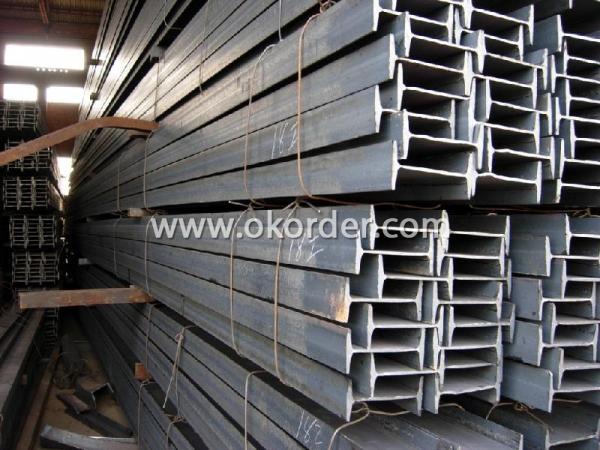
Applications of IPE/IPEAA Beam Steel
IPE/IPEAA Beam Steel are widely used in various construction structures, bridges, autos, brackets, mechanisms and so on.
Packing & Delivery Terms of IPE/IPEAA Beam Steel
1. Package: All the IPE/IPEAA Beam Steel will be tired by wire rod in bundles
2. Bundle weight: not more than 3.5MT for bulk vessel; less than 3 MT for container load
3. Marks:
Color marking: There will be color marking on both end of the bundle for the cargo delivered by bulk vessel. That makes it easily to distinguish at the destination port.
Tag mark: there will be tag mark tied up on the bundles. The information usually including supplier logo and name, product name, made in China, shipping marks and other information request by the customer.
If loading by container the marking is not needed, but we will prepare it as customer request.
4. Shipment: In containers or in bulk cargo
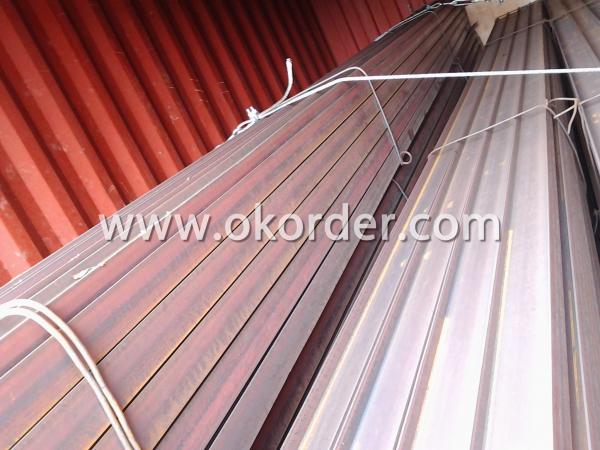
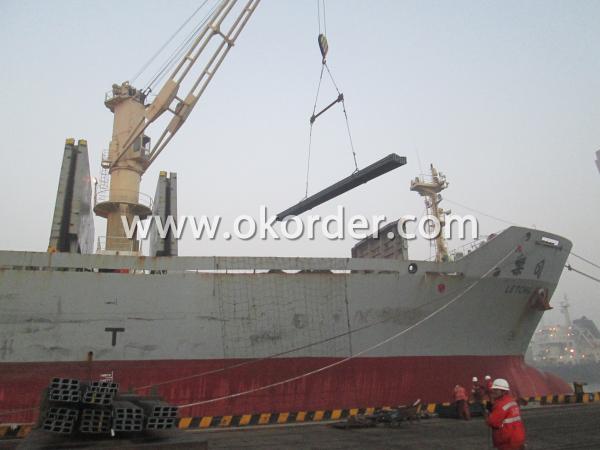
5. Delivery time: All the IPE/IPEAA Beam Steel will be at the port of the shipment within 45 days after receiving the L/C at sight ot the advance pyment.
6. Payment: L/C at sight; 30% advance payment before production, 70% before shipment by T/T, etc.
Production flow of IPE/IPEAA Beams
Material prepare (billet) —heat up—rough rolling—precision rolling—cooling—packing—storage and transportation
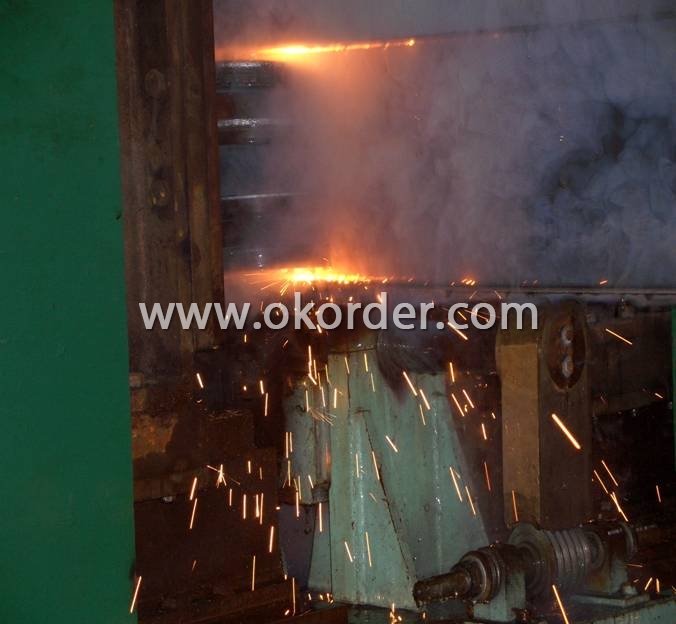
- Q: What are the cost considerations of using steel I-beams?
- There are several cost considerations when using steel I-beams in construction projects. Firstly, the initial cost of steel I-beams is generally higher compared to alternative materials such as wood or concrete. This is because steel is a more expensive material to produce and requires specialized manufacturing processes. However, the long-term benefits of steel, such as its durability and strength, often outweigh the initial cost. Another cost consideration is the installation process. Steel I-beams require skilled labor and specialized equipment for proper installation. Hiring qualified professionals for this task can increase the overall project cost. Additionally, the weight of steel I-beams can also impact transportation costs, as they may require larger trucks or cranes for delivery and placement. However, one of the major advantages of steel I-beams is their low maintenance requirements. Steel is resistant to decay, pests, and rot, which reduces the need for regular repairs and replacements. This can result in long-term cost savings as compared to materials that may require frequent upkeep. Furthermore, steel I-beams offer exceptional strength and load-bearing capabilities, allowing for wider spans and less need for additional support structures. This can significantly reduce the number of beams required for a project, ultimately lowering costs. Lastly, it is important to consider the overall lifecycle cost of steel I-beams. While the initial investment may be higher, the longevity and durability of steel make it a cost-effective choice in the long run. Its resistance to weathering and its ability to withstand heavy loads over time can result in lower replacement and maintenance costs compared to other materials. In conclusion, while steel I-beams may have a higher initial cost and require specialized labor and equipment for installation, their durability, low maintenance requirements, and long-term cost savings make them an attractive option for many construction projects.
- Q: How do steel I-beams contribute to the overall sustainability of a construction project?
- Steel I-beams contribute to the overall sustainability of a construction project in several ways. Firstly, steel is a highly durable and long-lasting material. Steel I-beams have a lifespan of several decades and can withstand extreme weather conditions and heavy loads without deteriorating. This longevity reduces the need for frequent replacement and repairs, reducing waste and conserving resources in the long run. Secondly, steel is a highly recyclable material. Steel I-beams can be easily recycled at the end of their lifespan, with the recycled steel being used to create new products. This recycling process significantly reduces the demand for raw materials and energy required for steel production, leading to a lower carbon footprint. Moreover, steel I-beams are lightweight compared to other construction materials such as concrete. This reduces the weight load on the foundation and overall structure, resulting in reduced materials and less energy consumption during construction. Additionally, the lightweight nature of steel I-beams allows for more efficient transportation, reducing fuel consumption and greenhouse gas emissions during transportation. Furthermore, steel I-beams are versatile and can be prefabricated off-site. This reduces construction waste and minimizes the impact on the surrounding environment during the construction process. Prefabrication also allows for faster construction, reducing the overall project timeline and minimizing disruption to the surrounding community. Lastly, steel I-beams can be designed and engineered to optimize energy efficiency. They can be integrated with insulation materials, thermal breaks, and other energy-saving features to enhance the overall energy performance of a building. This leads to reduced energy consumption for heating and cooling, resulting in lower operational costs and a smaller environmental footprint. In conclusion, steel I-beams contribute to the overall sustainability of a construction project through their durability, recyclability, lightweight nature, versatility, and potential for energy efficiency. They promote responsible resource use, waste reduction, and energy conservation, making them an environmentally-friendly choice for construction.
- Q: There are no columns in the middle of the workshop of 37 meters span. How much I-beam do I need?
- H type I-beam is also called wide flange I-beam, HW, HM, HN originated from European standards, HEB is the German standard of I-beam, of which HW, HN I-beam has been widely used in our country and production. HEA HEB HEM will be seen on many German designs and is hard to buy on the domestic market. In the domestic steel structure engineering, if the quantity is few, then may use the specification steel plate to carry on the welding splicing. In the case of large quantities, it is usually considered to use mechanical properties comparable to those of HW and HN steel.
- Q: Can steel I-beams be used in offshore platform construction?
- Yes, steel I-beams can be used in offshore platform construction. They are commonly used due to their high strength-to-weight ratio, durability, and ability to withstand harsh marine environments.
- Q: What are the common challenges faced when using steel I-beams in construction?
- In construction, the utilization of steel I-beams presents several common challenges. One of these challenges pertains to the weight and size of the beams. The beams themselves can be exceedingly heavy and large, thereby complicating their transportation and installation. Achieving accurate placement and positioning necessitates the utilization of specialized equipment and techniques. Furthermore, the beams' size can impose limitations on design flexibility and necessitate careful planning to ensure proper fit and alignment. Another challenge involves the potential for deflection and sagging. Under load, steel I-beams have the capacity to experience deflection, which can undermine the overall integrity and stability of the structure. To minimize deflection, it is imperative to conduct proper calculations and engineering analysis to ascertain the appropriate size and spacing of the beams. Corrosion represents a significant challenge as well when employing steel I-beams. Steel is prone to rusting and corrosion, particularly in environments characterized by high humidity or exposure to moisture. Regular maintenance and the application of protective coatings are indispensable measures for preventing deterioration and prolonging the beams' lifespan. Fire resistance emerges as another challenge in the context of steel I-beams. Although steel is a non-combustible material, it can lose its strength and structural integrity when subjected to high temperatures. Consequently, the implementation of fire protection measures, such as fire-resistant coatings or the use of fireproofing materials, becomes necessary to ensure the safety and structural stability of the building. Lastly, cost can prove to be a challenge when employing steel I-beams. In comparison to other construction materials, steel can be more expensive, which can impact the overall project budget. Moreover, the need for specialized equipment, coatings, and fire protection measures can further inflate the cost of utilizing steel I-beams in construction. In summary, despite the numerous advantages offered by steel I-beams in terms of strength and durability, their utilization in construction is accompanied by several challenges. Successfully overcoming these challenges and ensuring the effective implementation of steel I-beams in construction projects demands meticulous planning, engineering analysis, maintenance, and budgeting.
- Q: How do you calculate the bending deflection due to axial load in a steel I-beam?
- To determine the bending deflection resulting from an axial load in a steel I-beam, one must take into account the beam's geometry, material properties, and applied load. The process can be outlined as follows: 1. Measure the I-beam's dimensions, including its height (h), flange width (b), flange thickness (tf), and web thickness (tw), to determine the geometry. 2. Calculate the moment of inertia (I), which measures the beam's resistance to bending. This can be done using the formula: I = (1/12) * b * h^3 - (1/12) * (b - tw) * (h - 2 * tf)^3. This equation considers the I-beam's cross-sectional shape. 3. Determine the modulus of elasticity (E), which represents the steel material's stiffness. This value is typically provided in material specifications or can be obtained through testing. 4. Calculate the bending stress (σ) using the formula: σ = M * c / I, where M is the moment caused by the axial load and c is the distance from the cross-section's centroid to the extreme fiber. 5. Determine the axial load (P), which is the force applied along the beam's longitudinal axis. This information can be obtained from load analysis or structural design. 6. Calculate the bending deflection (δ) using the formula: δ = (P * L^3) / (3 * E * I), where L represents the span length of the beam. This equation is based on the Euler-Bernoulli beam theory for deflection caused by axial load. By following these steps, one can determine the bending deflection in a steel I-beam resulting from an axial load. It is important to note that this calculation assumes linear elastic behavior and does not account for factors like shear deformation and local buckling, which may require more advanced analysis techniques.
- Q: Can steel I-beams be used in entertainment venues or theaters?
- Yes, steel I-beams can be used in entertainment venues or theaters. These beams are commonly used in construction due to their strength and load-bearing capabilities. In entertainment venues and theaters, steel I-beams are often employed in the structural design to support the weight of lighting rigs, sound systems, and other equipment. They provide a sturdy framework that ensures the safety and stability of the venue.
- Q: How do you install steel I-beams correctly?
- Careful planning and proper execution are necessary for the correct installation of steel I-beams to ensure safety and structural integrity. Follow these step-by-step instructions to install steel I-beams correctly: 1. Select suitable beam size and length: Calculate the load-bearing requirements and span distance to choose the appropriate steel I-beam size and length. To ensure accuracy, consult a structural engineer or professional. 2. Prepare the site: Clear the area where the I-beams will be installed by removing debris and obstructions. Ensure that the foundation or supporting structure is in place and meets the necessary specifications. 3. Clean and inspect the I-beams: Thoroughly clean the steel I-beams to remove dirt, rust, or debris that could affect their stability. Inspect the beams for any defects or damage and address them accordingly. 4. Position the I-beams: Lift the I-beams carefully into position using suitable lifting equipment, such as a crane or forklift. Ensure proper alignment with the foundation or supporting structure. 5. Secure the I-beams: Use appropriate connectors or brackets to fasten the I-beams securely to the foundation or supporting structure. Follow the manufacturer's specifications and use the correct type and size of connectors. 6. Check alignment and level: Verify that the installed I-beams are level and properly aligned. Use a spirit level or laser level for accuracy. Make adjustments if necessary. 7. Weld or bolt connections: Depending on the design and specifications, secure the connections between the I-beams and other structural components by welding or bolting. Follow safety procedures and adhere to welding or bolting codes and standards. 8. Inspect and reinforce: Conduct a thorough inspection of the installed I-beams, paying attention to welds, connections, and potential stress points. Strengthen weak areas or make necessary adjustments as recommended by the engineer. 9. Obtain necessary approvals: Ensure that the installation complies with local building codes and regulations before proceeding with further construction or load-bearing activities. Obtain required permits and inspections. 10. Seek professional assistance: If you lack experience or confidence in installing steel I-beams, it is important to consult a professional or structural engineer to oversee the process and provide guidance. They can ensure correct installation and compliance with relevant standards and regulations. Always remember that the proper installation of steel I-beams is crucial for the structural integrity of a building or structure. Seeking professional advice and assistance is recommended to ensure a safe and accurate installation.
- Q: How do steel I-beams perform in terms of sustainability?
- Steel I-beams are highly sustainable due to their durability, recyclability, and energy efficiency. They have a long lifespan, require minimal maintenance, and can be recycled at the end of their use. Furthermore, steel production processes have become more environmentally friendly, reducing emissions and energy consumption. As a result, steel I-beams are an excellent choice for sustainable construction and infrastructure projects.
- Q: How do you calculate the torsional stiffness of a steel I-beam?
- To calculate the torsional stiffness of a steel I-beam, you need to consider its geometry and material properties. The torsional stiffness measures the beam's resistance to twist under a torsional load. First, you need to determine the cross-sectional dimensions of the I-beam, such as the flange width, flange thickness, web height, and web thickness. These dimensions can be found in the beam's specifications or measured directly. Next, calculate the moment of inertia for each component of the I-beam. The moment of inertia represents the beam's resistance to bending and twisting. For an I-beam, you need to calculate the moment of inertia for both the flanges and the web. The moment of inertia for the flanges can be calculated using the formula I = (b * h^3) / 12, where b is the flange width and h is the flange thickness. Calculate this for both the top and bottom flanges. The moment of inertia for the web can be calculated using the formula I = (w * h^3) / 12, where w is the web thickness and h is the web height. Then, sum up the moments of inertia for all components of the I-beam to get the total moment of inertia. Finally, use the formula T = (G * J) / L, where T is the torsional stiffness, G is the shear modulus of elasticity of the steel, J is the polar moment of inertia (equal to the total moment of inertia for an I-beam), and L is the length of the beam. By plugging in the values you calculated, you can determine the torsional stiffness of the steel I-beam. Keep in mind that the torsional stiffness may vary along the length of the beam, so this calculation represents an average value.
1. Manufacturer Overview
| Location | Tangshan, China |
| Year Established | 2009 |
| Annual Output Value | Above US$ 230 Million |
| Main Markets | Mid East; Southeast Asia; Korea |
| Company Certifications | ISO 9001:2008; |
2. Manufacturer Certificates
| a) Certification Name | |
| Range | |
| Reference | |
| Validity Period |
3. Manufacturer Capability
| a) Trade Capacity | |
| Nearest Port | Tianjin; |
| Export Percentage | 81% - 90% |
| No.of Employees in Trade Department | 21-50 People |
| Language Spoken: | English; Chinese; |
| b) Factory Information | |
| Factory Size: | Above 500,000 square meters |
| No. of Production Lines | 1 |
| Contract Manufacturing | OEM Service Offered; |
| Product Price Range | Average |
Send your message to us
IPE/IPEAA Beam Steel
- Loading Port:
- Tianjin Port, China
- Payment Terms:
- TT or LC
- Min Order Qty:
- 25MT m.t.
- Supply Capability:
- 10000MT m.t./month
OKorder Service Pledge
OKorder Financial Service
Similar products
Hot products
Hot Searches
Related keywords
